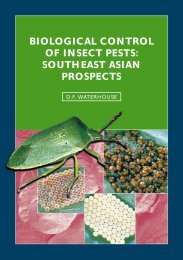Adobe PDF - EcoPort
Adobe PDF - EcoPort
Adobe PDF - EcoPort
You also want an ePaper? Increase the reach of your titles
YUMPU automatically turns print PDFs into web optimized ePapers that Google loves.
Competitive impact of Amaranthus spinosus and Corchorus olitorius in Nigeria. 57<br />
Amaranthus spinosus and Celosia argentea are members<br />
of the same family. They probably have similar growth<br />
requirements, hence the keen competition between the two<br />
species for nutrients and probably moisture. The duration<br />
of competition probably contributed to the competitive<br />
effects as weed density and duration of association induced<br />
significant reduction in the stem diameter. In the field, stem<br />
diameter was significantly reduced beyond three weeds/<br />
plant and four weeks of competitive interaction. Ogunyemi<br />
et al.(2001) showed similar reduction in crop performance<br />
when Solanum nigrum grew in association with Amaranthus<br />
cruentus. Ogunyemi et al (2000) also obtained similar results<br />
in the study of the competitive interaction between<br />
Amaranthus spinosus and Glycine max.<br />
The performance of Corchorus olitorius was adversely<br />
affected by competition from Amaranthus spinosus.<br />
It is clear from the study that the critical period of interference<br />
of A. spinosus with C. olitorius lies between the first 2-4<br />
weeks of growth. This agrees with Biswas (1986) who<br />
reported 2WAP as the critical period of weed competition<br />
for Corchorus olitorius. Smith (1974) reported similar results<br />
for rice in competition with Echinochloa crus-galli. Abamu<br />
(1995) also reported that reduction in rice grain dry weight<br />
resulted from increase in the time of crop-weed association.<br />
In both potherbs, the parameters plant height, stem diameter<br />
and number of leaves are of great value in the<br />
marketability of the vegetables. Any weed interaction that<br />
causes significant reductions in these parameters deserves<br />
serious attention. Vegetable growers do not normally sell<br />
by dry weight or even fresh weight in Nigeria, but by size as<br />
indicated by height and leafiness. The subsequent presence<br />
of weed after weedfree period (wf-wd) from four weeks<br />
onward probably enhanced the yield of C. olitorius by<br />
ameliorating crop environment, especially if moisture is not<br />
limiting. Awodoyin (2000) reported that at 1600 hours in 5<br />
cm soil depth the presence of weed on soil surface compared<br />
to weedfree plot had 8.8% reduction on soil temperature.<br />
References<br />
Abamu, J.A. 1995. Evaluating a crop-weed simulation model as<br />
a tool for weed management in irrigated transplanted rice<br />
(Oryza sativa). Ph.D thesis submitted to the faculty of the<br />
graduate school, University of the Philippines, Los Banos.<br />
174pp.<br />
Awodoyin, R. O. 2000. Biology of sicklepod [Senna obtusifolia<br />
(L.) Irwin and Barneby] and its potential in weed control.<br />
Ph.D Thesis, University of Ibadan, Nigeria. 247pp.<br />
Biswas, D.K. 1996. Integrated weed control in Jute. In<br />
Abstract of papers, India Soc. of Weed Science. p68.<br />
Burkhill, J.M. 1985. Flora of West Tropical Africa (1 st edition,<br />
London) Crown Agent, Vol. 2:346-352.<br />
Gomez, K. A., & Gomez, A.A. 1984. Statistical procedure for<br />
agricultural Research. John Wiley and Sons. 2nd Edition<br />
680pp.<br />
Hall, M.R., Swanton, J.C. & Anderson, G.W. 1992. The critical<br />
period of wed control in grain corn ( Zea may). Weed Science<br />
40, 441-447.<br />
Holm, L.G., Plucknett, D.l., Panchap, J.O. & Herbeger, J.P.<br />
(1997). The world’s worst weeds: distribution and biology.<br />
University press, Hawaii, Honolulu, 602p. Horticulture<br />
Agencyof International development, Washington.<br />
Ogunyemi, Sola, Awodoyin, R. O. & Otu, N. A. 2000.<br />
Chemical Control of Ageratum conyzoides, Amaranthus<br />
spinosus and Cyperus rotundus in soyabeans [ Glycine max<br />
(L.) Merril.]. Journal of Tropical Forest Resources 16(1):143-<br />
151.<br />
Ogunyemi, Sola, Ngwanyi, C.V. & Awodoyin, R.O. 2002.<br />
Interference of Solanum nigrum L. with the performance of<br />
Amaranthus cruentus L. Nigerian Journal of Plant Protection<br />
19, 56-64<br />
Shrefter, J.W., Stall, W.M. & Dusky, J.A.1996. Spiny<br />
Amaranth ( Amaranthus spinosus L.), a serious competitor<br />
to crisped head lettuce (Lactuca sativa L.) Hortscience<br />
31, 347-348.<br />
Smith(Jr.), R.J. 1974. Competition of Barnyard grass with<br />
Rice cultivars. Weed Science 22, 423-426.






